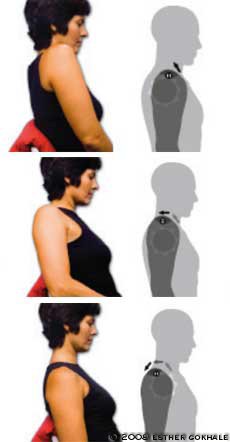Holiday Health (Posture Tips)

One shoulder at a time — a little forward,
a little up, a lot back, and totally relax.
The holidays are upon us and ‘tis the season for cooking, cleaning and entertaining. You may find yourself especially reliant upon your body as you enjoy the added festivities. We want to help keep you safe and healthy with some seasonal posture tips!
Shoulder positioning
Whether you are baking dozens of cookies or wrapping bundles of presents, your shoulders may feel uncomfortable if neglected. Firstly, assess your surroundings. Whatever your task, ensure that it is within comfortable reach. For example, if you are cooking, get close enough to your countertop so you can easily manage all of your ingredients. Or, if you are working while seated, find a suitable height for your chair and/or table. From here, do a shoulder roll. One shoulder at a time — a little forward, a little up, a lot back, and totally relax. Ideally you can still reach what you need without pulling the shoulders out of this position. This will alleviate tension or pulling between your shoulder blades, which over time would tax your rhomboid muscles. And, with the shoulders back and down, you will encourage healthy circulation to your arms and hands to keep up your stamina.

Notice how the baby's knees are bent in a wide stance to
allow his pelvis to settle comfortably between his legs.
Hip-Hinging
Decorating, cooking and preparing for house guests all require a lot of bending. Bending well by hip-hinging is a must to keep your back healthy. Always allow the legs to rotate open to make room for the pelvis. You want to make room for the pelvis to rotate, drop and nest between the legs.
For shallow bends, you will likely not need to bend your knees very much if at all while standing. If you are seated, the legs usually don’t have to be very far apart. As you bend forward, nothing else along your spine and torso moves. Your shoulders want to stay back, your neck remains elongated, and your ribs stay in place.
For deeper bends, the knees will probably need to bend more generously depending on your hamstring flexibility. If you are gathering things from the floor, you may want to take a wider stance as well, especially if those hamstrings are pulling your pelvis into a tucked position rather than the optimal tipped or anteverted position. Deep seated bends will likely feel better when the legs are opened as well.

This man uses his inner corset to lift a box.
Notice that his arms are still close to his
torso and his body is squared toward
the object.
Lifting with your Inner Corset
Heavy or bulky items require a great reliance upon your Inner Corset. While maintaining your hip-hinging form, add your Inner Corset AND bend your knees more generously when lifting heavy items. Often resting an elbow or two on your thigh can provide more leverage as well. And, always stay close to whatever you are handling—things feel heavier the further they are from your center.
Hopefully you can square your body toward any object you are handling. Sometimes, however (especially in decorating or cleaning those hard to reach spots) you may find your self in a slightly twisted, distorted, otherwise compromised position. During these times, it is especially vital to use your Inner Corset for extra protection. Creating more length allows room for the spine to handle bits of distortion. And, gathering your muscles up and in will stabilize your spine and prevent unnecessary compression.
Join us in an upcoming Free Workshop (online or in person).
Find a Foundations Course in your area to get the full training on the Gokhale Method!
We also offer in person or online Initial Consultations with any of our qualified Gokhale Method teachers.
Wishing everyone a warm holiday season!
Esther

Comments
Add New Comment
Login to add commment
Login